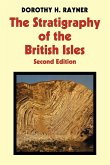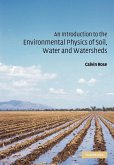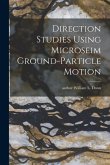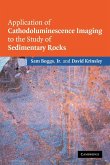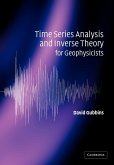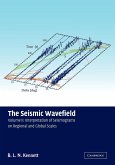Principles, Methods and Application of Particle Size Analysis
Herausgeber: Syvitski, James P. M.
Principles, Methods and Application of Particle Size Analysis
Herausgeber: Syvitski, James P. M.
- Broschiertes Buch
- Merkliste
- Auf die Merkliste
- Bewerten Bewerten
- Teilen
- Produkt teilen
- Produkterinnerung
- Produkterinnerung
Much of the world's surface, even under the oceans, is covered in thick deposits of sedimentary particles - gravel, sand, silt and clay. The nature of the deposits and their formation is very much dependent on the distribution of particles of different sizes. However, different instruments measure different attributes of a particle's size, based on how fast a particle settles in water, or the surface area of a particle, or its length. This book provides information on the how and why of particle size analysis in terms of understanding these sediment deposits.
Andere Kunden interessierten sich auch für
![Stratigraphy of the British Isles Stratigraphy of the British Isles]() Dorothy Helen RaynerStratigraphy of the British Isles92,99 €
Dorothy Helen RaynerStratigraphy of the British Isles92,99 €![An Introduction to the Environmental Physics of Soil, Water and Watersheds An Introduction to the Environmental Physics of Soil, Water and Watersheds]() Calvin W. RoseAn Introduction to the Environmental Physics of Soil, Water and Watersheds104,99 €
Calvin W. RoseAn Introduction to the Environmental Physics of Soil, Water and Watersheds104,99 €![Correlation of Domestic Stoker Combustion With Laboratory Tests and Types of Fuels. III. Effect of Coal Size Upon Combustion Characteristics; Report of Investigations No. 133 Correlation of Domestic Stoker Combustion With Laboratory Tests and Types of Fuels. III. Effect of Coal Size Upon Combustion Characteristics; Report of Investigations No. 133]() Roy John HelfinstineCorrelation of Domestic Stoker Combustion With Laboratory Tests and Types of Fuels. III. Effect of Coal Size Upon Combustion Characteristics; Report of Investigations No. 13314,99 €
Roy John HelfinstineCorrelation of Domestic Stoker Combustion With Laboratory Tests and Types of Fuels. III. Effect of Coal Size Upon Combustion Characteristics; Report of Investigations No. 13314,99 €![Direction Studies Using Microseim Ground-particle Motion Direction Studies Using Microseim Ground-particle Motion]() Direction Studies Using Microseim Ground-particle Motion14,99 €
Direction Studies Using Microseim Ground-particle Motion14,99 €![Application of Cathodoluminescence Imaging to the Study of Sedimentary Rocks Application of Cathodoluminescence Imaging to the Study of Sedimentary Rocks]() Sam Jr. BoggsApplication of Cathodoluminescence Imaging to the Study of Sedimentary Rocks61,99 €
Sam Jr. BoggsApplication of Cathodoluminescence Imaging to the Study of Sedimentary Rocks61,99 €![Time Series Analysis and Inverse Theory for Geophysicists Time Series Analysis and Inverse Theory for Geophysicists]() David GubbinsTime Series Analysis and Inverse Theory for Geophysicists103,99 €
David GubbinsTime Series Analysis and Inverse Theory for Geophysicists103,99 €![The Seismic Wavefield The Seismic Wavefield]() Brian KennettThe Seismic Wavefield93,99 €
Brian KennettThe Seismic Wavefield93,99 €-
-
-
Much of the world's surface, even under the oceans, is covered in thick deposits of sedimentary particles - gravel, sand, silt and clay. The nature of the deposits and their formation is very much dependent on the distribution of particles of different sizes. However, different instruments measure different attributes of a particle's size, based on how fast a particle settles in water, or the surface area of a particle, or its length. This book provides information on the how and why of particle size analysis in terms of understanding these sediment deposits.
Produktdetails
- Produktdetails
- Verlag: Cambridge University Press
- Seitenzahl: 388
- Erscheinungstermin: 14. August 2007
- Englisch
- Abmessung: 254mm x 178mm x 21mm
- Gewicht: 728g
- ISBN-13: 9780521044615
- ISBN-10: 0521044618
- Artikelnr.: 23143860
- Herstellerkennzeichnung
- Libri GmbH
- Europaallee 1
- 36244 Bad Hersfeld
- gpsr@libri.de
- Verlag: Cambridge University Press
- Seitenzahl: 388
- Erscheinungstermin: 14. August 2007
- Englisch
- Abmessung: 254mm x 178mm x 21mm
- Gewicht: 728g
- ISBN-13: 9780521044615
- ISBN-10: 0521044618
- Artikelnr.: 23143860
- Herstellerkennzeichnung
- Libri GmbH
- Europaallee 1
- 36244 Bad Hersfeld
- gpsr@libri.de
List of contributors; Preface; Acknowledgements; Part I. Introduction: 1.
Principles and methods of geological particle size analysis I. N. McCave
and James P. M. Syvitski; 2. The effect of grain shape and density on size
measurement Martin D. Matthews; 3. The effect of pretreatment on size
analysis Martin D. Matthews; Part II. Theory and Methods: 4. Principles,
design and calibration of settling tubes James P. M. Syvitski, Kenneth W.
Asprey and D. A. Clattenburg; 5. Methodology of sieving small samples and
calibration of sieve set Kristian Dalsgaard, Jens Ledet Jensen and Michael
Sørenson; 6. Image analysis method of grain size measurement Stephen K.
Kennedy and Jim Mazzullo; 7. Quantitative grain form analysis Julian D.
Orford and W. Brian Whalley; 8. Electroresistance particle size analyzers
T. G. Milligan and Kate Kranck; 9. Laser diffraction size analysis Y. C.
Agrawal, I. N. McCave and J. B. Riley; 10. SediGraph technique John P.
Coakley and James P. M. Syvitski; 11. Size, shape, composition and
structure of microparticles from light scattering Miroslaw Jonasz; 12.
Textural maturity of arenaceous rocks derived by microscopic grain size
analysis in thin section Song Tianrui; 13. Interlaboratory, interinstrument
calibration experiment James P. M. Syvitski, K. William G. LeBlanc and
Kenneth W. Asprey; Part III. In Situ Methods: 14. In situ size measurements
of suspended particles in estuarine and coastal waters using laser
diffraction A. J. Bale and A. W. Morris; 15. The Floc Camera Assembly David
E. Heffler, James P. M. Syvitski and Kenneth W. Asprey; Part IV. Data
Interpretation and Manipulation: 16. Suite statistics: the hydrodynamic
evolution of the sediment pool William F. Tanner; 17. The hyperbolic
distribution Christian Christiansen and Daniel Hartmann; 18. Factor
analysis of size frequency distributions: significance of factor solutions
based on simulation experiments James P. M. Syvitski; 19.
Experimental-theoretical approach to interpretation of grain size frequency
distributions Supriya Sengupta, J. K. Ghosh and B. S. Mazumder; Part V.
Applications: 20. Application of suite statistics to stratigraphy and
sea-level changes William F. Tanner; 21. Application of size sequence data
to glacial-paraglacial sediment transport and sediment partitioning Jay A.
Stravers, James P. M. Syvitski, and Dan B. Praeg; 22. The use of grain size
information in marine geochemistry Dale E. Buckley and Ray E. Cranston; 23.
Grain size in oceanography Kate Kranck and T. G. Milligan; 24. The need for
grain size analyses in marine geotechnical studies Francis J. Hein; Index.
Principles and methods of geological particle size analysis I. N. McCave
and James P. M. Syvitski; 2. The effect of grain shape and density on size
measurement Martin D. Matthews; 3. The effect of pretreatment on size
analysis Martin D. Matthews; Part II. Theory and Methods: 4. Principles,
design and calibration of settling tubes James P. M. Syvitski, Kenneth W.
Asprey and D. A. Clattenburg; 5. Methodology of sieving small samples and
calibration of sieve set Kristian Dalsgaard, Jens Ledet Jensen and Michael
Sørenson; 6. Image analysis method of grain size measurement Stephen K.
Kennedy and Jim Mazzullo; 7. Quantitative grain form analysis Julian D.
Orford and W. Brian Whalley; 8. Electroresistance particle size analyzers
T. G. Milligan and Kate Kranck; 9. Laser diffraction size analysis Y. C.
Agrawal, I. N. McCave and J. B. Riley; 10. SediGraph technique John P.
Coakley and James P. M. Syvitski; 11. Size, shape, composition and
structure of microparticles from light scattering Miroslaw Jonasz; 12.
Textural maturity of arenaceous rocks derived by microscopic grain size
analysis in thin section Song Tianrui; 13. Interlaboratory, interinstrument
calibration experiment James P. M. Syvitski, K. William G. LeBlanc and
Kenneth W. Asprey; Part III. In Situ Methods: 14. In situ size measurements
of suspended particles in estuarine and coastal waters using laser
diffraction A. J. Bale and A. W. Morris; 15. The Floc Camera Assembly David
E. Heffler, James P. M. Syvitski and Kenneth W. Asprey; Part IV. Data
Interpretation and Manipulation: 16. Suite statistics: the hydrodynamic
evolution of the sediment pool William F. Tanner; 17. The hyperbolic
distribution Christian Christiansen and Daniel Hartmann; 18. Factor
analysis of size frequency distributions: significance of factor solutions
based on simulation experiments James P. M. Syvitski; 19.
Experimental-theoretical approach to interpretation of grain size frequency
distributions Supriya Sengupta, J. K. Ghosh and B. S. Mazumder; Part V.
Applications: 20. Application of suite statistics to stratigraphy and
sea-level changes William F. Tanner; 21. Application of size sequence data
to glacial-paraglacial sediment transport and sediment partitioning Jay A.
Stravers, James P. M. Syvitski, and Dan B. Praeg; 22. The use of grain size
information in marine geochemistry Dale E. Buckley and Ray E. Cranston; 23.
Grain size in oceanography Kate Kranck and T. G. Milligan; 24. The need for
grain size analyses in marine geotechnical studies Francis J. Hein; Index.
List of contributors; Preface; Acknowledgements; Part I. Introduction: 1.
Principles and methods of geological particle size analysis I. N. McCave
and James P. M. Syvitski; 2. The effect of grain shape and density on size
measurement Martin D. Matthews; 3. The effect of pretreatment on size
analysis Martin D. Matthews; Part II. Theory and Methods: 4. Principles,
design and calibration of settling tubes James P. M. Syvitski, Kenneth W.
Asprey and D. A. Clattenburg; 5. Methodology of sieving small samples and
calibration of sieve set Kristian Dalsgaard, Jens Ledet Jensen and Michael
Sørenson; 6. Image analysis method of grain size measurement Stephen K.
Kennedy and Jim Mazzullo; 7. Quantitative grain form analysis Julian D.
Orford and W. Brian Whalley; 8. Electroresistance particle size analyzers
T. G. Milligan and Kate Kranck; 9. Laser diffraction size analysis Y. C.
Agrawal, I. N. McCave and J. B. Riley; 10. SediGraph technique John P.
Coakley and James P. M. Syvitski; 11. Size, shape, composition and
structure of microparticles from light scattering Miroslaw Jonasz; 12.
Textural maturity of arenaceous rocks derived by microscopic grain size
analysis in thin section Song Tianrui; 13. Interlaboratory, interinstrument
calibration experiment James P. M. Syvitski, K. William G. LeBlanc and
Kenneth W. Asprey; Part III. In Situ Methods: 14. In situ size measurements
of suspended particles in estuarine and coastal waters using laser
diffraction A. J. Bale and A. W. Morris; 15. The Floc Camera Assembly David
E. Heffler, James P. M. Syvitski and Kenneth W. Asprey; Part IV. Data
Interpretation and Manipulation: 16. Suite statistics: the hydrodynamic
evolution of the sediment pool William F. Tanner; 17. The hyperbolic
distribution Christian Christiansen and Daniel Hartmann; 18. Factor
analysis of size frequency distributions: significance of factor solutions
based on simulation experiments James P. M. Syvitski; 19.
Experimental-theoretical approach to interpretation of grain size frequency
distributions Supriya Sengupta, J. K. Ghosh and B. S. Mazumder; Part V.
Applications: 20. Application of suite statistics to stratigraphy and
sea-level changes William F. Tanner; 21. Application of size sequence data
to glacial-paraglacial sediment transport and sediment partitioning Jay A.
Stravers, James P. M. Syvitski, and Dan B. Praeg; 22. The use of grain size
information in marine geochemistry Dale E. Buckley and Ray E. Cranston; 23.
Grain size in oceanography Kate Kranck and T. G. Milligan; 24. The need for
grain size analyses in marine geotechnical studies Francis J. Hein; Index.
Principles and methods of geological particle size analysis I. N. McCave
and James P. M. Syvitski; 2. The effect of grain shape and density on size
measurement Martin D. Matthews; 3. The effect of pretreatment on size
analysis Martin D. Matthews; Part II. Theory and Methods: 4. Principles,
design and calibration of settling tubes James P. M. Syvitski, Kenneth W.
Asprey and D. A. Clattenburg; 5. Methodology of sieving small samples and
calibration of sieve set Kristian Dalsgaard, Jens Ledet Jensen and Michael
Sørenson; 6. Image analysis method of grain size measurement Stephen K.
Kennedy and Jim Mazzullo; 7. Quantitative grain form analysis Julian D.
Orford and W. Brian Whalley; 8. Electroresistance particle size analyzers
T. G. Milligan and Kate Kranck; 9. Laser diffraction size analysis Y. C.
Agrawal, I. N. McCave and J. B. Riley; 10. SediGraph technique John P.
Coakley and James P. M. Syvitski; 11. Size, shape, composition and
structure of microparticles from light scattering Miroslaw Jonasz; 12.
Textural maturity of arenaceous rocks derived by microscopic grain size
analysis in thin section Song Tianrui; 13. Interlaboratory, interinstrument
calibration experiment James P. M. Syvitski, K. William G. LeBlanc and
Kenneth W. Asprey; Part III. In Situ Methods: 14. In situ size measurements
of suspended particles in estuarine and coastal waters using laser
diffraction A. J. Bale and A. W. Morris; 15. The Floc Camera Assembly David
E. Heffler, James P. M. Syvitski and Kenneth W. Asprey; Part IV. Data
Interpretation and Manipulation: 16. Suite statistics: the hydrodynamic
evolution of the sediment pool William F. Tanner; 17. The hyperbolic
distribution Christian Christiansen and Daniel Hartmann; 18. Factor
analysis of size frequency distributions: significance of factor solutions
based on simulation experiments James P. M. Syvitski; 19.
Experimental-theoretical approach to interpretation of grain size frequency
distributions Supriya Sengupta, J. K. Ghosh and B. S. Mazumder; Part V.
Applications: 20. Application of suite statistics to stratigraphy and
sea-level changes William F. Tanner; 21. Application of size sequence data
to glacial-paraglacial sediment transport and sediment partitioning Jay A.
Stravers, James P. M. Syvitski, and Dan B. Praeg; 22. The use of grain size
information in marine geochemistry Dale E. Buckley and Ray E. Cranston; 23.
Grain size in oceanography Kate Kranck and T. G. Milligan; 24. The need for
grain size analyses in marine geotechnical studies Francis J. Hein; Index.



